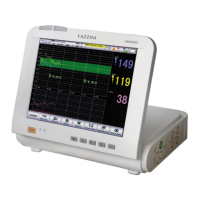FM5000C - FM5000PLUS
Maternal/Fetal Monitor
The function of arrhythmia monitoring can, by testing and classification of arrhythmias and heart
abnormalities, remind doctors to pay attention to the rhythm of the patient, and then give alarm.
The monitor can make 14 kinds of arrhythmia analysis.
Arrhythmia analysis system will store 200 alarm events and the operator can edit the arrhythmic events in
the menu.
15.8.1 Enabling Arrhythmia Analysis
(a) Select ECG parameter area;
(b) Enter the [ARR ANALYSIS]menu;
(c) Select [ARR ANALYSIS] and toggle between[ON] and [OFF].
15.8.2 Arrhythmia Alarm Settings
(a) Select ECG] parameter area, in the pop-up [ECG SETUP] menu, enter [ARR ANALYSIS]menu;
(b) Select [ARR ALARM];
(c) Select [ARR TYPE], select [ALL] or separate arrhythmia [ASYSTOLE], [VFIB/VTAC], [R ON T],
[VT> 2], [COUPLET], [PVC], [BIGEMINY], [TRIGEMINY], [TACHY.], [BRADY], [PNC], [PNP],
[MISSED BEATS],[ARRHYTHMIA];
(d) Others:
Upper and lower limit of alarm:
15.8.3 Arrhythmia Relearning
During ECG monitoring, when great changes of patient’s ECG template takes place, the users should start
the arrhythmia relearning process, which can help the monitor learn new ECG template tocorrect
arrhythmiaalarm and HR valuesandrestore ST measurement.
Particular procedures are:
(a) Select ECG parameter area, in the pop-up [ECG SETUP] menu, enter [ARR ANALYSIS]menu;
(b) Select [ARR RELEARN].
15.8.4 Arrhythmia Review
(a) Select ECG parameter area, in the pop-up[ECG SETUP] menu, enter [ARR ANALYSIS] menu;
(b) Select[ARR RECALL]to enter the arrhythmia review window, as shown below:

